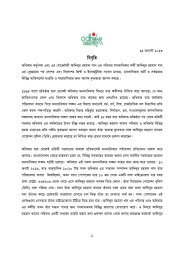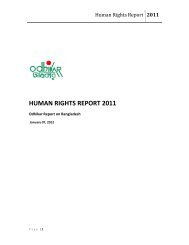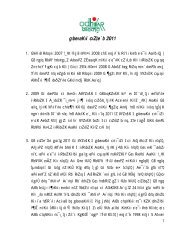Please - Odhikar
Please - Odhikar
Please - Odhikar
Create successful ePaper yourself
Turn your PDF publications into a flip-book with our unique Google optimized e-Paper software.
Witness intimidation includes threats against the victims of crimes strikes at the root of the<br />
criminal justice system by denying critical evidence to police investigators and prosecutors and<br />
by undermining the confidence of whole communities in the government's ability to protect and<br />
represent them.<br />
Two forms of witness intimidation are hampering the investigation and prosecution of crime<br />
throughout Bangladesh:<br />
� overt intimidation, when someone does something explicitly to intimidate a witness; and<br />
� implicit intimidation, when there is a real but unexpressed threat of harm, as when rampant<br />
gang violence creates a community-wide atmosphere of fear. Most overt intimidation occurs<br />
only when there is a previous connection between the defendant and the victim, and when they<br />
live relatively close to each other.<br />
It is very difficult to ascertain the precise extent of witness intimidation in Bangladesh, because<br />
no scientific research has been conducted on the problem yet. But it is agreed that witness<br />
intimidation is widespread, that it is increasing, and that it seriously affects the prosecution of<br />
violent crimes.<br />
Intimidation -- whether of an individual or a community -- may involve the following tactics:<br />
� physical violence,<br />
� explicit threats of physical violence,<br />
� implicit threats,<br />
� property damage, and<br />
� courtroom intimidation.<br />
Attempts by gangs or drug dealers to promote community-wide non-cooperation may include<br />
the public humiliation or assault, or even execution of victims or witnesses (or members of their<br />
families), as well as isolated public acts of extreme brutality that, intentionally or<br />
unintentionally, terrify potential witnesses.<br />
High incidence of threats of physical violence against victims, witnesses, and their families is<br />
present in the society. Threats are much more common than actual violence but that threats were<br />
often just as effective in deterring cooperation because in gang- and drug-dominated<br />
communities these threats are credible. Threats against a victim's or witness's mother, children,<br />
wife, or partner were cited as being particularly effective forms of intimidation.<br />
A third common form of intimidation, reported in almost every jurisdiction, involves indirect<br />
intimidation, such as gang members standing outside a victim's or witness's house, nuisance<br />
phone calls, and vague verbal warnings by the defendant or his or her associates. Only slightly<br />
less common than the three types of intimidation described above is intimidation involving the<br />
destruction of property: drive-by shootings into a witness's house, fire-bombing, burning of<br />
houses, hurling bricks through the window of home, and other types of violence.<br />
Another common form of intimidation occurs when friends or relatives of the defendant direct<br />
56<br />
Report 2005











